Getting organised
Getting organised
Following on from January’s post, I thought I’d talk a bit more about getting organised. On Saturday 21 January I presented a session for GSQ on Organising your research. This was planned as a practical course to provide suggestions on how to manage your paper records as well as your digital records. This proved to be quite popular and so we had to limit the numbers. I have agreed to offer this session again on 3 June, so if you missed out the first time, check GSQs website for more information.
It’s all very well to tell everyone how to organise their ‘stuff’, but it’s a bit rich when you don’t do it yourself, so I shared a guilty secret with attendees. This guilty secret was my messy study! My study is converted from the third bedroom. I had decided over the Christmas break that I needed to re-organise my files. I have a 3-drawer filing cabinet, 2 units which have 2 drawers and a filing drawer which fit under my desk, as well as a cupboard which has four shelves and a top shelf. One wall is converted to a full-width, full-height, custom-made bookshelf. You would think that would be sufficient space, but apparently not, because I have a lot of other stuff besides that relating to family history.
I decided that the only way I could guarantee to re-organise would be to take everything genealogical out of the filing drawers, pile it up on the floor and, following my advice to attendees, tackle one pile at a time. These photos show the study floor in various stages of the sorting process. I hadn’t yet started on the cupboard.
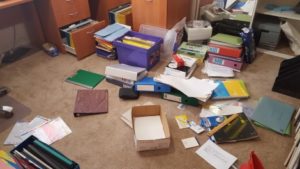
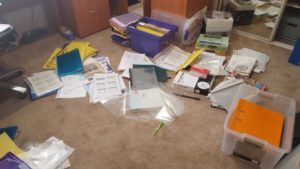 As this blog is intended to be about things genealogical, I won’t labour the point about my perceived messiness. While I found the sorting and organising process quite time-consuming and physically demanding as I was sitting on the floor most of the time, there were some significant benefits. The major benefit was taking the time to look at material that I hadn’t explored for quite some time. In focussing on my maternal line in recent years, I had done little on my paternal line, which is where my genealogy journey began some 20 years ago.
As this blog is intended to be about things genealogical, I won’t labour the point about my perceived messiness. While I found the sorting and organising process quite time-consuming and physically demanding as I was sitting on the floor most of the time, there were some significant benefits. The major benefit was taking the time to look at material that I hadn’t explored for quite some time. In focussing on my maternal line in recent years, I had done little on my paternal line, which is where my genealogy journey began some 20 years ago. 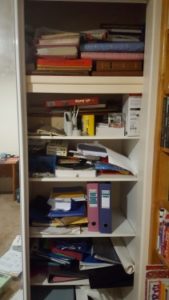
This is a brief and general summary of what I discovered as I sorted:
- Documents that were in the wrong place and thus were unlikely to be found without an intensive search, knowing that I had them somewhere;
- Duplicates of certificates and/or other documents;
- Materials that I had sourced at various times, but had never analysed and used in my research;
- Materials which were inappropriately stored.
This demonstrated to me yet again that it’s a waste of time and money to re-do research you have done years earlier, but there is great value in reviewing what you have in light of release of new records or discovery of new leads. You never know but you might have been following the wrong family or you’d missed a crucial piece of information by not analysing a document thoroughly.
As you go through the sorting process, ideas may pop into your head about how to organise a particular set of records. This may require you to go back over some of your earlier work, but the end result will probably be worth it. One decision I made related to hard copies of the many presentations that I have given over the past decade. Although I have copies of everything on my computer, I decided not to discard all the hard copies at this stage. I therefore created an intermediate storage option between filing in my study and tossing in the bin. I have a beautiful shelving system in my garage and these materials have therefore been demoted to the garage. It’s worth noting that about the only thing that doesn’t go into the garage is my car! This decision released a significant amount of space in the filing drawers.
There was a distinct sense of achievement as I gradually reduced the material in the piles of folders into a structure that, if all goes w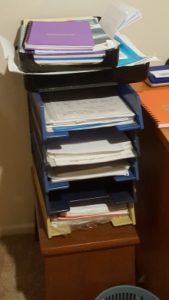 ell, will work for me for the foreseeable future.
ell, will work for me for the foreseeable future.
I mentioned earlier that some of the material I came across had not been fully analysed. I have four filing trays, one for each of my foundation families, and rather than file the papers away immediately, I’ve put them in the relevant tray so I can work my way through them as and when I have time. One appears to be empty as I’ve been working mostly on my maternal lines recently.
The end result of all my sorting and filing is space. I don’t feel hemmed in by piles of ‘stuff’. It’s easier to find what I want and also to work out what I need. The next phase in my re-organisation is to decide what to do with the bookshelf; the bottom three shelves are primarily given over to genealogy/family history books and magazines and folders of general reference or contextual information. I also have boxes of magazines in the garage.
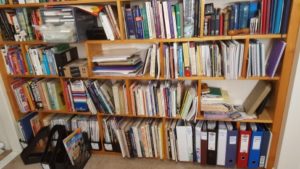
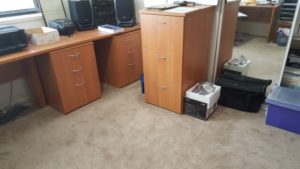 I’d be interested in hearing whether others keep their genealogy magazines indefinitely, donate them or throw them away in due course, and/or whether they have switched to electronic versions to try and reduce the physical demands for storage. In the past I have donated them to Lifeline and I welcome any other suggestions you may have.
I’d be interested in hearing whether others keep their genealogy magazines indefinitely, donate them or throw them away in due course, and/or whether they have switched to electronic versions to try and reduce the physical demands for storage. In the past I have donated them to Lifeline and I welcome any other suggestions you may have.
I offered attendees at the presentation various options for organising their records as well as links to many online resources. I don’t think there is one ‘right’ way for everyone; what works for you will depend on your materials, available space, method of working. I would recommend that you research the range of options that are out there and adapt what you like to your own situation. At least when I next offer the Organising your genealogy records session in June, I will be able to say that I practice what I preach.
Until next time
Pauline

Comments
Getting organised — No Comments
HTML tags allowed in your comment: <a href="" title=""> <abbr title=""> <acronym title=""> <b> <blockquote cite=""> <cite> <code> <del datetime=""> <em> <i> <q cite=""> <s> <strike> <strong>